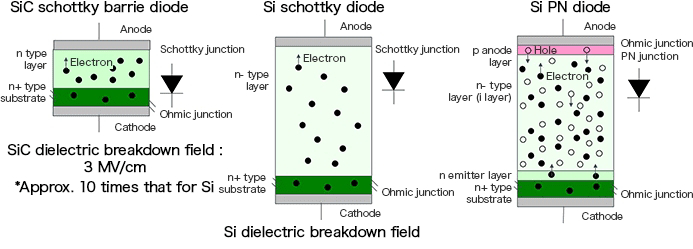➡️Depending on the recovery characteristics and manufacturing techniques, thepower diodes can be classified into the following three categories:1. Standard or general-purpose diodes2. Fast-recovery diodes3. Schottky diodesGeneral-purpose diodes are available up to 6000 V, 4500 A, and the rating offast-recovery diodes can go up to 6000 V, 1100 A. The reverse recovery timevaries between 0.1 s and 5 s. The fast-recovery diodes are essential for high-frequency switching of power converters.Schottky diodes have a low on-state voltage and a very small recoverytime, typically in nanoseconds. The leakage current increases with the voltagerating and their ratings are limited to 100 V, 300 A. A diode conducts when itsanodevoltage is higher than that of the cathode; and the forward voltage drop of apowerdiode is very low, typically 0.5 V to 1.2 V.
✏️General-Purpose Diodes
➡️The general-purpose rectifier diodes have relatively high reverse recovery time,typically25 s; and are used in low-speed applications, where recovery time isnot critical(e.g., diode rectifiers and converters for a low-input frequency up to1-kHz applications and line-commutated converters).These diodes cover current ratings from less than 1 A to several thousands ofamperes, with voltage ratings from 50 V to around 5 kV.These diodes are generally manufactured by diffusion.Basically fall into two types.One is called a stud, or stud-mounted type;the other is called a disk,press pak, or hockey-pucktype. In a stud-mounted type,either the anode or thecathode could be the studied.
✏️Fast-Recovery Diodes
➡️The fast-recovery diodes have low recovery time, normally less than 5 s.They areused in dc–dc and dc–ac converter circuits, where the speed of recovery isoften ofcritical importance. These diodes cover current ratings of voltage from 50 Vto around 3 kV, and from less than 1 A to hundreds of amperes.For voltage ratings above 400 V,fast-recovery diodes are generallymade by diffusion and the recoverytime is controlled by platinum orgold diffusion.For voltage ratings below 400 V,epitaxial diodes provide fasterswitching speeds than those ofdiffused diodes. The epitaxialdiodes have a narrow base width,resulting in a fast recovery time ofas low as 50 ns.
✏️Schottky Diodes
➡️The charge storage problem of a pn-junction can be eliminated (or minimized) in aSchottky diode. It is accomplished by setting up a “barrier potential” with a contactbetween a metal and a semiconductor. A layer of metal is deposited on a thin epitaxiallayer of n-type silicon. The potential barrier simulates the behavior of a pn-junction. Therectifying action depends on the majority carriers only, and as a result there are noexcess minority carriers to recombine. The recovery effect is due solely to the selfcapacitance of the semiconductor junction.The recovered charge of a Schottky diode is much less than that of an equivalent pnjunctiondiode. Because it is due only to the junction capacitance, it is largely independentof the reverse di/dt. A Schottky diode has a relatively low forward voltagedrop.The leakage current of a Schottky diode is higher than that of a pn-junctiondiode. A Schottky diode with relatively low-conduction voltage has relatively highleakage current, and vice versa. As a result, the maximum allowable voltage of thisdiode is generally limited to 100 V. The current ratings of Schottky diodes vary from1 to 400 A. The Schottky diodes are ideal for high-current and low-voltage dc powersupplies. However, these diodes are also used in low-current power supplies for electronic equipments.
✏️Silicon Carbide Diodes
➡️Silicon carbide (SiC) is a new material for power electronics. Its physical propertiesoutperform Si and GaAs by far. For example, the Schottky SiC diodes manufacturedby Infineon Technologies [3] have ultralow power losses and high reliability. They alsohave the following features:• No reverse recovery time;• Ultrafast switching behavior;• No temperature influence on the switching behavior.The typical storage charge QRR is 21 nC for a 600-V, 6-A diodeand is 23 nC for a 600-V, 10-A device.The low reverse recovery characteristic of SiC diodes, hasalso a low reverse recovery current. It saves energy in manyapplications such as power supplies, solar energy conversion,transportations, and other applications such as weldingequipment and air conditioners. SiC power devices enableincreased efficiency, reduced solution size, higher switchingfrequency, and produce significant less electromagneticinterference (EMI) in a variety of applications.
✏️Silicon Carbide Schottky Diodes
➡️Schottky diodes are used primarily in high frequency and fast-switching applications.Many metals can create a Schottky barrier on either silicon or GaAs semiconductors.A Schottky diode is formed by joining a doped semiconductor region, usually n-type, witha metal such as gold, silver, or platinum.Unlike a pn-junction diode, there is a metal to semiconductor junction.The Schottky diode operates only with majority carriers.There are no minority carriers and thus no reverse leakage current as in pn-junctiondiodes.The metal region is heavily occupied with conduction band electrons, and the n-typesemiconductor region is lightly doped.When forward biased, the higher energy electrons in the n-region are injected into themetal region where they give up their excess energy very rapidly.Since there are no minority carriers, it is a fast switching diode.
➡️The SiC Schottky diodes have the following features:• Lowest switching losses due to low reverse recovery charge;• Fully surge-current stable, high reliability, and ruggedness;• Lower system costs due to reduced cooling requirements;• Higher frequency designs and increased power density solutions.These devices also have low device capacitance that enhances overall system efficiency,especially at higher switching frequencies.










No comments:
Post a Comment
If you have any doubts or clarification you need in my blog topics, I would 💯 try to clear it in an efficient manner as possible. I will also accept your suggestions.